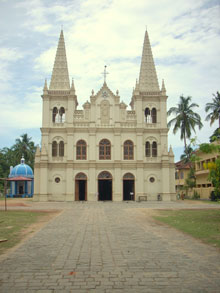Photos

Fort Cochin
Fort Kochi takes its name from the Fort Immanuel that adorned the shores of Cochin, once upon a time. Fort Kochi is now a bustling tourist town on the Arabian Coast. Its historical and cultural background there for all of us to learn. The walkways, wide streets, rows of bungalows are all reminiscent of its old glory. Even before Vasco da Gama helped bring in the Portuguese, Fort Kochi was already a trade town - the Jews and Arabs had started trade relations with South India, via Fort Kochi.
There are many interesting places to visit in Fort Kochi. The beach itself is a beauty! Then there is the St Francis Church built by Portuguese Franciscan friars in 1503. It was also conquered and used by the Dutch, and later the British. The Dutch Palace, Governor's Bungalow, Dutch Cemetery, Maritime Museum and the Indo-Portuguese Museum are other attractions. Do not miss to watch how fishermen operate the Chinese Fishing Nets on the Fort Kochi beach and around.
Fort Kochi is only 16km from the heart of Cochin town. You can reach here by taxis and AC buses. There are ferries that will take you to Cochin mainland and Vypeen.
Places to See
Chinese fishing nets
Chinese Fishing Nets, found only in and around Cochin, are large cantilevered fishing nets that are supposed to have been brought from China in the late 14th century. Fort Kochi, Vypeen and Kumbalanghi are the major areas where you can find these beauties. The poles are built with bamboo and teak wood.
Mattancherry Synagogue
Standing at the end of the touristy road in Mattancherry, the street leading up to it has many handicraft and artifact shops. The synagogue's premises house five Jewish families.
The synagogue was built in 1568, with a clock tower that was added later by Ezekiel Rahabi. King Bhaskara Ravi Varma's 4th century decree that guaranteed the Jewish settlers domain over Cranganore (Kodungalur), Hebrew-inscribed stone slabs and Old Testament scrolls are important relics of the religious place. You can see that each of the hand-painted Chinese tiles are different.
The Cochin Club
Earlier called the English Club, this elite club is a typical colonial era building. It is sandwiched between the Fort Cochin Commandant's house and the Governor's residence. The arches and roofs of building add to the charm of the décor. There's a garden that goes round most of the building, and there's a grand library and a trophy collection.
Santa Cruz Basilica
This church was built by the Portuguese and elevated to a Cathedral by Pope IV in 1558. In 1795 it fell into the hands of the British when they took over Cochin and it was demolished. Over 100 years later, Bishop Ferreira commissioned a new building at the same site in 1887. Pope John Paul II proclaimed it a Basilica in 1984.
Old Harbor House
Built in 1808, this house is now in the possession of Carrit Moran & Co, renowned tea brokers. They use it as their residence. The house was once a boat club.
Pierce Leslie Bungalow
Founded in 1862, this elegant colonial mansion was the office of the coffee merchants, the Pierce Leslie and Company. The structure is a blend of Portuguese, Dutch and the native building style. The mansion has arched doorways, wood panels on the roof of the ground floor, carved doors, sprawling rooms and waterfront verandahs.
VOC Gate
The VOC gate was built in 1740. The large wooden gate facing the Parade Ground has the monogram (VOC) of the once mighty Dutch East India Company carved on it.
The Dutch Cemetery
The tombstones here are the most authentic record of the hundreds of Europeans who left their homeland in a mission to expand their colonial empires and who changed the course of history of the land they conquered. The cemetery was consecrated in 1724 and is today managed by Church of South India.
St Francis Church
Built in 1503 by Portuguese Franciscan fathers, this is India's oldest European church. This was initially built of timber and later reconstructed in stone. It was restored in 1779 by the Protestant Dutch, converted to an Anglican church by the British in 1795 and is at present governed by the Church of South India. Vasco da Gama was buried here in 1524 before his mortal remains were moved to Lisbon, Portugal. The tombstone still stands within the church.

Vasco Cafe
We serve variety of breakfast which include continental, south indian homely food. Freshly grounded Kerala coffee, fresh juices, fruits, pancakes, homemade cakes, milk shakes and ice cream are available here. Lunch is also on offer, and you can choose from an array of dishes with Fish, Prawns, Chicken, fresh vegetable and many more. You can order for lunch and dinner too.